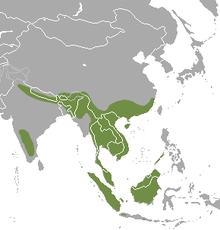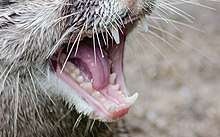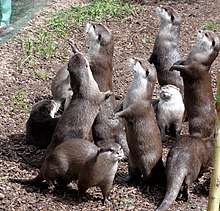Asian small-clawed otter
The Asian small-clawed otter (Amblonyx cinereus), also known as the oriental small-clawed otter or simply small-clawed otter, is a semiaquatic mammal native to South and Southeast Asia. This monotypic genus is a member of the otter subfamily (Lutrinae) of the weasel family (Mustelidae), and is the smallest otter species in the world.[2] Its paws are a distinctive feature; its claws do not extend beyond the fleshy end pads of its partially webbed fingers and toes. This gives it a high degree of manual dexterity so that it can use its paws to feed on molluscs, crabs and other small aquatic animals.
| Asian small-clawed otter | |
|---|---|
 | |
| Scientific classification | |
| Kingdom: | Animalia |
| Phylum: | Chordata |
| Class: | Mammalia |
| Order: | Carnivora |
| Family: | Mustelidae |
| Subfamily: | Lutrinae |
| Genus: | Amblonyx Rafinesque, 1832 |
| Species: | A. cinereus |
| Binomial name | |
| Amblonyx cinereus (Illiger, 1815) | |
 | |
| Asian small-clawed otter range | |
| Synonyms | |
|
Aonyx cinereus | |
The Asian small-clawed otter inhabits mangrove swamps and freshwater wetlands in South and Southeast Asia. It lives in extended family groups with only the alpha pair breeding; offspring from previous years help to raise the young. Due to ongoing habitat loss, pollution, and hunting in some areas, it is listed as Vulnerable on the IUCN Red List.[1]
Taxonomy
Lutra cinerea was the scientific name proposed by Johann Karl Wilhelm Illiger in 1815 for an otter collected in Batavia.[3] In the 19th and 20th centuries, several zoological specimens were described:
- Lutra concolor proposed by Constantine Samuel Rafinesque in 1832 was a uniform coloured otter from Assam. Rafinesque also proposed Amblonyx as name of a subgenus for otters with short, obtuse claws.[4]
- Lutra leptonyx proposed by Thomas Horsfield in 1824 were two adult small-clawed otters collected in Java.[5] It was subordinated to the genus Aonyx by John Edward Gray in 1843.[6]
- Amblonyx cinerea nirnai proposed by Reginald Innes Pocock in 1940 was a dark brown small-clawed otter from Virajpet in South India.[7]
Results of a mitochondrial cytochrome B analysis published in 1998 indicated that it should be subordinated to the genus Aonyx.[8] Results of a molecular study published in 2008 showed that the Asian small-clawed otter is a sister taxon of Lutrogale, lending support to retaining the genus Amblonyx. They genetically diverged about 1.5 million years ago.[9]
The Asian small-clawed otter groups with the African clawless otter and the smooth-coated otter into a sister clade to the genus Lutra. Hybridisation of Asian small-clawed otter females with smooth-coated otter males occurred in Singapore. The resulting offspring and their descendants bred back into the smooth-coated otter population, but maintained the genes of their small-clawed otter ancestors. Today, a population of at least 60 hybrid otters exist in Singapore.[10]
Characteristics

The Asian small-clawed otter has deep brown fur with some rufous tinge on the back, but paler below. Its underfur is lighter near the base. The sides of the neck and head are brown, but its cheeks, upperlip, chin, throat and sides of the neck are whitish.[11] Its skull is short, and the naked rhinarium rounded above. The muzzle has long coarse vibrissae on either side. Its eyes are located toward the front of the head. The small ears are oval-shaped with an inconspicuous tragus and antitragus. Its paws are narrow with short digits that are webbed to the last joint. There are short hairs on the lower sides of the interdigital webs. The four-lobed plantar pads are longer than wide. The claws are short, almost erect, and in some individuals even absent.[12] Females have four mammary glands.[13]
The Asian small-clawed otter is the smallest otter species in Asia. In head-to-body length, it ranges from 470 to 610 mm (18.4 to 24 in) with a 260 to 350 mm (10.2 to 13.6 in) long tail. The tapering tail is thick and muscular, especially at the base, and more than half the length of the body. Hind feet are 97 to 102 mm (3.8 to 4 in) long. Length of skull ranges from 3.3 to 3.7 in (84 to 94 mm). It does not have upper premolars and only four postcanine teeth above.[14] Adult captive otters range in weight from 2.7 to 3.5 kg (6.0 to 7.7 lb).[15]
Distribution and habitat
The Asian small-clawed otter is distributed from India to Southeast Asia including the islands of Sumatra, Java, Borneo and Palawan. In southern India, it occurs along shallow mountain creeks in hill ranges up to an elevation of 2,000 m (6,600 ft) in Karnataka, Nilgiri and Palni hills in Tamil Nadu. Farther north, it occurs in coastal regions of Odisha, and in wetlands in West Bengal, Assam and Arunachal Pradesh. It inhabits freshwater wetlands such as swamps, meandering rivers, irrigated rice fields as well as estuaries, coastal lagoons and tidal pools.[1] In western Java, it inhabits areas along slow-flowing irrigation channels, pond areas and rice fields surrounded by vegetation that offers shelter. It also occurs in mangroves.[16]
Behaviour and ecology

The Asian small-clawed otter is mostly active after dark.[17][18] It lives in groups of up to 15 individuals.[18] Group members communicate using 12 or more distinct calls, and utter a variety of yelps and whimpers.[13] When disturbed, they scream to rally the help of others.[19]
When swimming on the surface, otters row with the forelimbs and paddle with the hind limbs.[20] When diving under water, they undulate their bodies and tails. Captive otters swim at speeds of 0.7–1.2 m/s (2.3–3.9 ft/s).[15]
Observations of wild Asian small-clawed otters revealed that they smear their spraint at latrine sites, using their hind feet and tails. Large groups smeared more than groups of three or fewer animals. The frequency of latrines with smeared scats varied in different locations, indicating a preference for certain sites. Spraint smearing most likely facilitates social ties among group members and is associated with territorial marking displays. They use grassy or sandy banks for resting, sun bathing and grooming. In marshes, they use mostly islands.[18]
Diet

The Asian small-clawed otter feeds mainly on crabs, mudskippers and Trichogaster fish. Its diet varies seasonally. When and where available, it also catches snakes, frogs, insects, rats and rice field fish like catfish, Anabas testudineus and Channa striata.[18] The size of crabs found in spraints in Huai Kha Khaeng Wildlife Sanctuary ranged in carapace width from 10 to 44 cm (3.9 to 17.3 in).[21] Captive Asian small-clawed otters were observed to leave shellfish in the sun so that the heat causes them to open. That way, they consume the meat without having to crush the shells.[13]
The hindmost upper teeth (pm4 and m3) are broad and robust and are specialized for crushing the exoskeletons of crabs and other hard shelled prey. They hunt food by using their vibrissae to detect movements of prey in the water. They use their forepaws to locate and capture items rather than their mouths. Their incomplete webbing gives them a great deal of manual dexterity.
Reproduction
Information about the Asian small-clawed otter's mating and breeding behaviour has been studied in captive environments. Captive pairs are monogamous. The estrous cycle of females lasts 28 to 30 days with estrus lasting between one and 13 days. Usually, mating takes place in the water.[22] Gestation lasts 62 to 86 days. Interval between births is at least eight months.[23] About two weeks before parturition, both female and male engage in building a nest. They collect grass, hay or straw and carry this material into the breeding chamber. Between one and seven pups are born in a litter. Pups are born with closed eyes, which open in the fifth week.[22] Newborn pups weigh between 45.6 and 62.5 g (1.61 and 2.20 oz) and reach a weight of 410–988 g (14.5–34.9 oz) after 60 days.[24] They start exploring the environs of the breeding den at the age of ten weeks. At about three months, they enter and paddle in shallow water under the guidance of the mother. They become independent at the age of four to five months.[22]
Threats
The Asian small-clawed otter is threatened by poaching for its fur, loss and destruction of habitats such as hill streams, peat swamp forests and mangroves for aquaculture projects. Threats in India include deforestation, conversion of natural habitat for tea and coffee plantations, overfishing of rivers and water pollution through pesticides.[1]
It is the most sought after otter species for the illegal pet trade in Asia. At least 711 Asian small-clawed otters were offered for sale through online websites by 280 traders in Indonesia, Thailand, Malaysia and Vietnam between 2016 and 2017.[25] Between December 2015 and October 2018, 49 Asian small-clawed otters were confiscated from wildlife traffickers in Thailand, Vietnam and Japan; 35 of them were bound for sale in Japan.[26]
Conservation
The Asian small-clawed otter was listed on CITES Appendix II and is protected in almost all range countries prohibiting its killing.[1] Since August 2019, it is included in CITES Appendix I, thus strengthening its protection in regards to international trade.[27]
In captivity
The Association of Zoos and Aquariums established a Species Survival Plan for the Asian small-clawed otter in 1983 to encourage research on captive breeding.[28]
In Europe, Zoo Basel keeps Asian small-clawed otters together with Indian rhinoceros.[29]
References
- Wright, L., de Silva, P., Chan, B. & Reza Lubis, I. (2015). "Aonyx cinereus". IUCN Red List of Threatened Species. 2015: e.T44166A21939068. Retrieved 29 October 2018.CS1 maint: multiple names: authors list (link)
- Foster-Turley, P.; Engfar, S. (1988). "The Species Survival Plan for the Asian small-clawed otter Aonyx cinerea". International Zoo Yearbook. 27: 79–84. doi:10.1111/j.1748-1090.1988.tb03199.x.
- Illiger, C. (1815). "Überblick der Säugethiere nach ihrer Verteilung über die Welttheile". Abhandlungen der Königlichen Preußischen Akademie der Wissenschaften zu Berlin. 1804−1811: 39−159. Archived from the original on 4 April 2019. Retrieved 12 June 2020.
- Rafinesque, C. S. (1832). "Description of a New Otter, Lutra concolor, from Assam in India". Atlantic journal, and friend of knowledge in eight numbers : containing about 160 original articles and tracts on natural and historical sciences, the description of about 150 new plants, and 100 new animals or fossils ; many vocabularies of languages, historical and geological facts. Philadelphia. p. 62.
- Horsfield, T. (1824). "Lutra leptonyx". Zoological researches in Java, and the neighbouring islands. London: Kingsbury, Parbury & Allen. pp. 185–191.
- Gray, J. E. (1843). "The Wargul. Aonyx leptonyx". List of the specimens of Mammalia in the collection of the British Museum. p. 71.
- Pocock, R. I. (1940). "Notes on Some British Indian Otters, with Description of Two new Subspecies". The Journal of the Bombay Natural History Society. 41 (3–4): 514–517.
- Koepfli, K.-P. & Wayne, R. K. (1998). "Phylogenetic relationships of otters (Carnivora: Mustelidae) based on mitochondrial cytochrome B sequences". Journal of Zoology. 246 (4): 401–416. doi:10.1111/j.1469-7998.1998.tb00172.x.CS1 maint: multiple names: authors list (link)
- Koepfli, K.P.; Kanchanasaka, B.; Sasaki, H.; Jacques, H.; Louie, K.D.Y.; Hoai, T.; Dang, N.X., Geffen, E., Gutleb, A., Han, S., Heggberget, T. M., LaFontaine, L., Lee, H., Melisch, R., Ruiz-Olmo, J., Santos-Reis, M., Sidorovich, V.E., Stubbe, M., Wayne, R.K. (2008). "Establishing the foundation for an applied molecular taxonomy of otters in Southeast Asia" (PDF). Conservation Genetics. 9 (6): 1589–1604. doi:10.1007/s10592-007-9498-5.CS1 maint: multiple names: authors list (link)
- Moretti, B.; Al-Sheikhly, O. F.; Guerrini, M.; Theng, M.; Gupta, B. K.; Haba, M. K.; Khan, W. A.; Khan, A. A. & Barbanera, F. (2017). "Phylogeography of the smooth-coated otter (Lutrogale perspicillata): distinct evolutionary lineages and hybridization with the Asian small-clawed otter (Aonyx cinereus)" (PDF). Scientific Reports. 7: 41611. doi:10.1038/srep41611. PMC 5269716. PMID 28128366.CS1 maint: multiple names: authors list (link)
- Blanford, W. T. (1888). "Lutra leptonyx. The clawless Otter". The Fauna of British India, Including Ceylon and Burma. Mammalia. London: Taylor and Francis. pp. 187–188.
- Pocock, R. I. (1921). "On the External Characters of some Species of Lutrinae (Otters)". Proceedings of the Zoological Society of London. 37 (3): 535–545.
- Timmins, W. H. (1971). "Observations on breeding the oriental short clawed otter Amblonyx cinerea at Chester Zoo". International Zoo Yearbook. 11: 109–111. doi:10.1111/j.1748-1090.1971.tb01868.x.
- Pocock, R. I. (1941). "Genus Amblonyx, Rafinesque". The Fauna of British India including Ceylon and Burma. Mammalia II. London: Taylor and Francis. pp. 303–317.
- Borgwardt, N.; Culik, B. M. (1999). "Asian small-clawed otters (Amblonyx cinerea): resting and swimming metabolic rates". Journal of Comparative Physiology B: Biochemical, Systemic, and Environmental Physiology. 169 (2): 100–106. doi:10.1007/s003600050199. PMID 10227184.
- Melisch, R.; Kusumawardhani, L.; Asmoro, P. B.; Lubis, I. R. (1996). The otters of west Java – a survey of their distribution and habitat use and a strategy towards a species conservation programme. Bogor, Indonesia: Wetlands International – Indonesia Programme.
- Hutton, A. F. (1949). "Notes on the Snakes and the Mammals of the High Wavy Mountains, Madura District, South India. Part II – Mammals". The Journal of the Bombay Natural History Society. 48 (4): 681–694.
- Foster-Turley, P. (1992). Conservation ecology of sympatric Asian otters Aonyx cinerea and Lutra perspicillata (Ph.D. Dissertation). Gainesville, Florida: University of Florida.
- Sivasothi, N.; Nor, B. H. M. (1994). "A review of otters (Carnivora: Mustelidae: Lutrinae) in Malaysia and Singapore". Hydrobiologia. 285 (1–3): 1–3. doi:10.1007/BF00005663.
- Fish, F. E. (1994). "Association of propulsive swimming mode with behaviour in the river otters (Lutra canadensis)". Journal of Mammalogy. 75 (4): 989–997. doi:10.2307/1382481. JSTOR 1382481.
- Kruuk, H.; Kanchanasaka, B.; O'Sullivian, S.; Wanghongsa, S. (1994). "Niche separation in three sympatric otters Lutra perspicillata, Lutra lutra and Aonyx cinerea in Huai Kha Khaeng, Thailand". Biological Conservation. 69: 115–210. doi:10.1016/0006-3207(94)90334-4.
- Lancaster, W. E. (1975). "Exhibiting and breeding the Asian small-clawed otter at Adelaide Zoo". International Zoo Yearbook. 15: 63–65. doi:10.1111/j.1748-1090.1975.tb01355.x.
- Sobel, G. (1996). Development and validation of noninvasive, fecal steroid monitoring procedures for the Asian small-clawed otter, Aonyx cinerea (Master of Science). Gainesville, Florida: University of Florida.
- Maslanka, M. T.; Crissey, S. D. (1998). "Nutrition and diet". In Lombardi, D.; O’Connor, J. (eds.). Asian small-clawed otter (Aonyx cinerea) husbandary manual. Powell, Ohio: Columbus Zoological Gardens and AZA Asian Small-Clawed Otter SSP. pp. 1–18.
- Gomez, L.; Bouhuys, J. (2018). Illegal Otter Trade in Southeast Asia (PDF). Kelana Jaya, Selangor, Malaysia: Traffic Southeast Asia Regional Office.
- Gomez, L.; Shepherd, C. R. (2019). "Stronger International Regulations and Increased Enforcement Effort is needed to end the Illegal Trade in Otters in Asia" (PDF). IUCN Otter Specialist Group Bulletin. 36 (2): 71–76.
- DTE Staff (2019). "CITES CoP 2019: Otters given highest protection from trade". DownToEarth.
- Foster-Turley, P. (1986). "A progress report on the species survival plan for Asian small-clawed otters in United States zoos". Otter Specialist Group Bulletin. 1: 19–21.
- "Zoo-Nachwuchs sorgt für Trubel". Zoo Basel (in German). 2012.
Further reading
- Payne, J., Francis, C.M., and Phillipps, K. (1994). A Field Guide to the Mammals of Borneo. Kota Kinabalu: The Sabah Society.
External links
| Wikispecies has information related to Aonyx cinerea |
| Wikimedia Commons has media related to Aonyx cinerea. |
- "Asian Small-clawed Otter". IUCN Otter Specialist Group.
- "Aonyx cinerea, Oriental small-clawed otter". Animal Diversity Web.
- "Asian small-clawed otter". Smithsonian’s National Zoo & Conservation Biology Institute.
- "Ban on endangered otter trade to take effect amid pet boom in Japan". Kyodo News. 2019.
